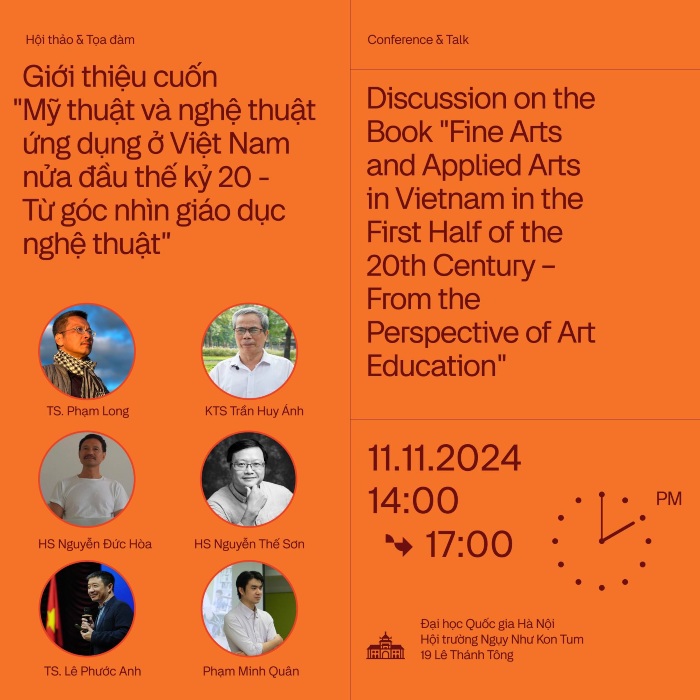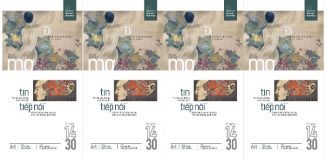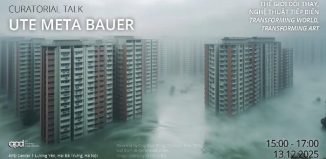Discussion on the Book “Fine Arts and Applied Arts in Vietnam in the First Half of the 20th Century – From the Perspective of Art Education”

02 pm – 05 pm, Mon 11 Nov 2024
Ngụy Như Kon Tum Hall
Vietnam National University
19 Lê Thánh Tông, Hoàn Kiếm, Hà Nội
From the organizer:
A discussion introducing the book Fine Arts and Applied Arts in Vietnam in the First Half of the 20th Century – From the Perspective of Art Education (published by the University of Education Publishing House, 2023), co-edited by Pham Long and Tran Hau Yen The, will be held from 2:00 PM to 5:00 PM on November 11, 2024, at Nguy Nhu Kon Tum Hall, 19 Le Thanh Tong, Hanoi. This book is a helpful scholarly reference that provides a comprehensive overview of the pivotal developments and changes in both the fine arts and art education in Vietnam during the first half of the 20th century.
The discussion will be chaired by Pham Minh Quan (School of Interdisciplinary Science and Arts, VNU), along with the following speakers: art researcher Dr. Pham Long, co-editor of the work; Dr. Architect Le Phuoc Anh (Head of the Department of Architecture, Urbanism, and Sustainable Science, School of Interdisciplinary Science and Arts, VNU); and artist Nguyen The Son (School of Interdisciplinary Science and Arts, VNU).
This work contributes to the field by providing archival information from history and journalism, helping to clarify the founding, formation, and development of the Indochina School of Fine Arts. It especially highlights the trend of expanding art education to include craftsmen and artisans. In addition to the traditional handcraft painters, this period saw the emergence of artists with highly personal creative expressions, marking a harmonious fusion of Vietnam’s artistic heritage and the Western spirit of liberal arts education.
At the same time, the book clarifies the contributions and influences of the Indochina School of Fine Arts on the development of Vietnamese society in various fields during the first half of the 20th century, extending into the present day. As scholar Dao Duy Anh noted in Vietnam Cultural History Outline (1938), “… In the history of our country’s art, this school (the Indochina School of Fine Arts) occupies a very important position as the center of a major reform movement.”
This major reform ran parallel to civil social organizations such as the Khai Tri Tien Duc Society, the Tri Tri Society, the Nha Anh Sang movement, and the Self-Strengthening Literary Group’s reform of clothing in the 1930s–1940s, as well as its seamless integration with the Hanoi Exhibition Grounds/Maurice Long Museum, creating an artistic ecosystem—a creative industrial cultural space. In this ecosystem, the School of Indochina Fine Arts served as the nucleus from which the model emerged.
Importantly, the book also discusses key figures who played vital roles in the formation and revival of both Vietnam’s fine arts and handicrafts. It reflects a spirit of pioneering, experimentation, and continuous improvement and reform, rather than being rigid, conservative, or doctrinaire, particularly highlighting the value of indigenous and national elements.
One cannot overlook the fact that the Indochina School of Fine Arts, as part of the Université Indochinoise, was an institutional framework that allowed for the effective development of interdisciplinary education in Vietnam as early as the 20th century. It initiated and stimulated the exchange of teachers, subjects, and training facilities among its member schools. This was a very progressive educational model, emphasizing cooperation and cross-disciplinary interaction, transcending traditional boundaries to generate creative ideas and foster individual, liberal development.













